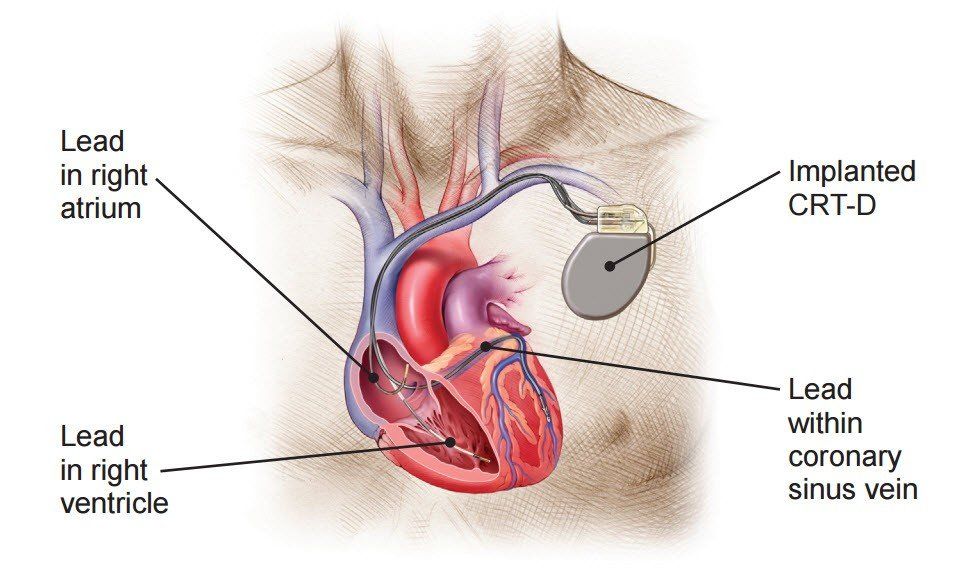Biventricular Implantable Cardioverter-Defibrillator ( BiV-ICD)
in Daytona Beach & Titusville, FL
Also known as Cardiac Resynchronization Therapy (CRT), it can improve heart function and strength while saving your life from deadly arrhythmias.
No one plans on having heart problems, but if you do you need to find a doctor you can trust. At Complete Cardiology Care we staff Cardiologists and Electrophysiologists that treat patients with Biventricular Implantable Cardioverter-Defibrillators or CRT devices in Daytona Beach, Ormond Beach, Palm Coast, Deltona, Deland, and the surrounding areas.
Treats fast heart beats
Reduce risks of sudden cardiac death
Multiple company options
Biotronik, Boston Scientific, Medtronic, or Abbott

What is a BiV ICD or CRT Device?
A Biventricular ICD is also known as a CRT-D device. CRT-D is an implantable cardiac resynchronization therapy (CRT) defibrillator for patients with heart failure. The device monitors the heart's rhythm, detects irregularities and corrects them with electrical impulses. Like an implantable defibrillator (ICD), a CRT-D is designed to stop life-threatening ventricular tachycardia and fibrillation with relatively weak and painless stimulation therapy or electrical shocks. CRT-Ds differ from ICDs in that they help your heart’s lower chambers – the ventricles – work in tandem. To do this, CRT-Ds have three leads – wires that deliver energy to the heart – rather than one or two, as in an ICD. A CRT-P is a cardiac resynchronization therapy pacemaker that does not have the defibrillation capabilities of a CRT-D. CRT-Ds enhance diseased hearts’ effectiveness and increase blood flow. They improve heart failure symptoms like fatigue, shortness of breath and exercise intolerance. Cardiac resynchronization therapy significantly lowers the risk of life-threatening cardiac events. Many patients’ quality of life improves significantly with a CRT-D. Surgery is necessary to implant a CRT-D.
What is the difference between an ICD and a CRT device
Function:
- CRT Device: A Cardiac Resynchronization Therapy (CRT) device is used primarily to treat heart failure with dyssynchrony, a condition where the heart's chambers do not contract in a coordinated manner. The CRT device helps synchronize the contractions of the heart's ventricles (lower chambers) to improve overall pumping efficiency.
- ICD Device: An Implantable Cardioverter-Defibrillator (ICD) device is designed to monitor the heart's rhythm and deliver a shock if it detects life-threatening arrhythmias, such as ventricular fibrillation or ventricular tachycardia. These arrhythmias can lead to sudden cardiac arrest.
Components:
- CRT Device: A CRT device typically includes two pacing leads placed in the right atrium and right ventricle, as well as an additional lead placed in the coronary sinus vein on the left side of the heart. This third lead helps synchronize the contractions of the left and right ventricles.
- ICD Device: An ICD device includes pacing leads similar to a CRT device, but it also has the capability to deliver high-energy shocks to restore a normal heart rhythm if a dangerous arrhythmia is detected.
Indications:
- CRT Device: CRT devices are mainly used for patients with heart failure who also have evidence of ventricular dyssynchrony, as indicated by a prolonged QRS duration on an electrocardiogram (ECG).
- ICD Device: ICD devices are typically recommended for patients at high risk of sudden cardiac death due to known or suspected ventricular arrhythmias.
Benefits:
- CRT Device: CRT can improve symptoms of heart failure, increase exercise tolerance, and reduce hospitalizations by improving the heart's pumping efficiency.
- ICD Device: ICDs can deliver life-saving shocks to terminate dangerous arrhythmias and prevent sudden cardiac death.
Combination Devices:
- Some devices, known as CRT-D devices, combine both CRT and ICD functions. These devices provide resynchronization therapy for heart failure and also have the capability to deliver defibrillation shocks when needed.
In summary, CRT devices focus on synchronizing the heart's contractions to improve heart failure symptoms, while ICD devices are primarily aimed at preventing sudden cardiac death by detecting and treating life-threatening arrhythmias. In some cases, both CRT and ICD functions are combined into a single device (CRT-D) to address multiple aspects of heart health.
No one knows BiV ICD or CRT-D like us - guaranteed.
If you are curious how we can help you with your Biventricular Implantable Cardioverter-Defibrillator or CRT Device in Daytona Beach, FL please reach out to us. We are currently accepting new patients. Complete Cardiology Care staffs Cardiologists and Electrophysiologist that serve patients in Ormond Beach, Daytona Beach, New Smyrna Beach, Port Orange, Deltona, Deland, and the surround areas.
Our Cardiologists and Electrophysiologist take nearly all insurances. We accept Aetna, AARP Medicare Complete, Blue Cross / Blue Shield, Cigna, Florida Healthcare, Florida Hospital Care Advantage, Freedom Health, Health First Health, Humana PPO - out of network benefits apply, Medicare, Optimum Healthcare, Railroad Medicare, Tricare, United Healthcare, VHN, Wellcare.
We are also a partner with the VA and are proud to serve those who have served our country!
Self Pay Cardiology services are available too! Call and ask for our price list.

